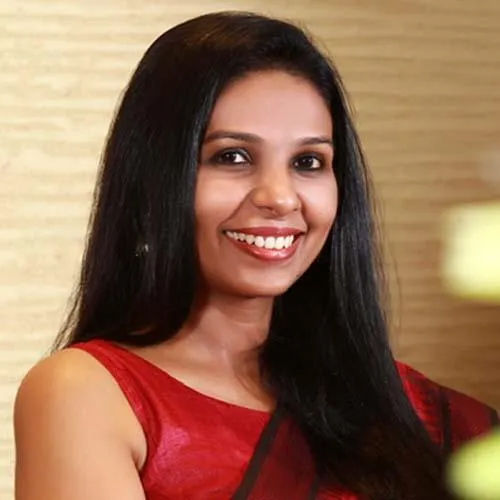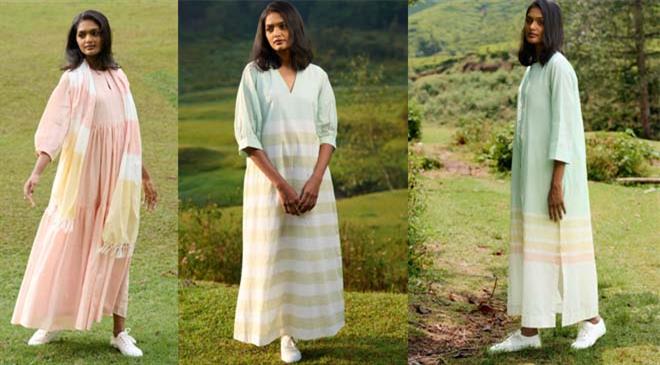
Shalini James
Founder
Brand - Mantra
Textile artisanship is the bedrock on which I built my design practice
Shalini James is the founder and lead designer of Mantra, an Indian clothing brand whose ready-to-wear garments, in hand-crafted textiles and standardised sizes, have done pioneering work by bringing a paradigm shift from customised designing to pret-a-porter. With a passion for design and handcrafts that began at a young age, James became an entrepreneur at the age of 28. In an interview with Fibre2Fashion, she talks about her inspiration behind Mantra, her brand’s design philosophy, her achievements, future plans, and a lot more.
Fibre2Fashion: What was your inspiration behind the launch of Mantra clothing brand?
Shalini James:
I was exposed to this profession from the age of 12. My mother, who was rather creatively inclined, had a design studio at home. Later, when the design unit grew out of our home into a much larger, organised set-up of about 60 karigars—embroidery artisans, tailors, and patternmakers—I spent all my free time there, pottering around with fabrics and trims. This early experience and exposure, especially to hand-crafted textiles, led me to pursue an education in fashion at NIFT, Chennai, and become a fashion entrepreneur at the age of 28.
F2F: How would you describe the design philosophy of your brand?
SJ:
For eighteen years, we have been making clothes with hand-crafted textiles—weaves, prints, and embroideries. For this, we have liaised with most Indian textile crafts and innumerable artisans across the country. Our rich and extensive textile heritage is deeply embedded in our DNA.
F2F: How do you balance the use of hand-crafted textiles with standardised sizing in your designs?
SJ:
Very early on, I realised, from my personal experience, and from market studies, that women who had a deep appreciation for Indian textiles, could not often find clothes made of these textiles in the right sizes. It was the ‘free-size raj’ everywhere for Indian wear. This lacuna in the ethnic wear industry needed to be filled with standardisation of sizing, seasonal styles, and high-quality tailoring.
F2F: How do you ensure that your designs are both fashionable and functional?
SJ:
Three things that go into my design process are: a deep reverence for Indian textiles, an understanding of trends in the fashion industry, and a frequently updated knowledge of customer preferences; always in that order. The balance of these three elements in my designs have ensured their relevance in terms of fashion and function.
F2F: How do you incorporate customer feedback into your design process?
SJ:
We are very open to customer feedback. We collect it systematically from our stores and online portals and incorporate it wherever necessary.
F2F: Can you tell us about your collaboration with textile artisans from across India and how it influences your design choices?
SJ:
Textile artisanship is the bedrock on which I built my design practice. From the inception of my business, I have been travelling to remote textile villages, interacting with artisans, and liaising with them. I treat textile artisanship and the knowledge guardians of our textile heritage with heartfelt respect and awe. Therefore, in my design process, the textile always reigns supreme. There is never an urge or attempt to put my stamp on the textile. Instead, I happily surrender to its stamp on me.
F2F: What was the research process behind devising your own size charts? How do you ensure the unique aesthetic and fit of your clothes?
SJ:
The research process involved identifying body-types, recruiting volunteers for each type, developing samples, test-fitting, altering, and test-fitting again till we arrive at an optimum fit. Once a sample set is approved, the measurement charts are finalised and given out to the design and production teams. The size charts have variations included, based on styles.
F2F: How has Mantra contributed to the revival, sustainability, and elevation of India’s hand-crafted textile heritage?
SJ:
Over the years, we have held on to our first premise that the key resource at Mantra would always be handloom and hand-crafted textiles. We have done copious amounts of work with artisans of Bagru, Sanganer, Bhuj, Phulia, Pochampally, Masulipatnam, Chendamangalam, and many more.
F2F: What major challenges have you faced in your journey, and how did you overcome them?
SJ:
Steering the brand through the pandemic was the biggest challenge I faced in my entrepreneurial journey. But thanks to my team, business associates, and a close coterie of supporters, we could get through the worst.
F2F: Can you share some of your achievements as a fashion designer in the fashion Industry?
SJ:
I’d count our vast customer base that believes in and endorses the brand Mantra as the biggest achievement in my long innings in the fashion industry.
F2F: Could you please share your future plans for the brand with us?
SJ:
We have plans to expand our retail presence to other parts of the country with collaborations with online portals, multi-designer outlets, and exclusive brand outlets in selected cities.

Rahul Mehta
Rahul Mehta
Pradip Mehta
Arun Sirdeshmukh
Abhay Gupta
Aseem Prakash
Bill D’Arienzo
Fanny Vermandel
Gabi Seligsohn
Anurag Batra



_8.JPG)









